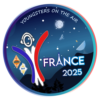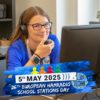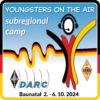Even with everybody still sleep deprived from the BACAR day, there wasn’t any time to catch up with sleep as the ambitious schedule continued on Sunday.
In preparation for what was going to take most of the day, including the tea breaks, Hans Summer, G0UPL, presented the next kit from his company, QRP Labs, that was going to be built. We won’t spoil anything here until Hans’ official announcement, but all we can say is that it is an amazing product, definitely one-upping last year’s QCX kit. It might or might not be the case that some information about it has spread throughout other YOTA media channels, so it is definitely worthwhile to look through the posts there as well.
However, when you try to beat a kit like the QCX, some people might be intimidated by the complexity; or they just want to build something that unexperienced kit builders can finish over the course of the camp. For this reason, Hans also brought other kits, namely his clock kit as well as the Ultimate3S WSPR kit, which builds upon the clock kit. For WSPR enthusiasts, you can be sure that there will be some rare WSPR DXCC(s) coming up rather soon!
With the presentation out of the way, it was time to start actually building the kits. While there weren’t enough soldering irons to keep everyone soldering without interruption (anyone want to lend ca. 80 irons to the next YOTA event? 😃), this also meant that more experienced builders could help the inexperienced one, creating a great learning experience. Also, with all the soldering fumes in the air, it probably was for the better that we did not have more.
At the same time, the lessons for the RAE (South African license exam) continued, an opportunity used by many to either upgrade their home license or take the exam in the first place, an opportunity not even offered in some of the countries participating.
The afternoon of that day had two more presentations. One was about DMR, including a small, portable repeater; something you probably won’t see for analog modes. The other presentation was about contesting, presented by non other than three-times WRTC participant Chris Burger, ZS6EZ. Part of the presentation was also the YOTA tradition of an Off-Air contest, although with different rules than the participants were used to. Nevertheless, it was about as chaotic as the ones we knew from earlier years.
After dinner, there was another Train the Trainer session, dedicated to trying to find each country’s challenges in getting and keeping youngsters interested in the hobby. With plenty of good ideas being exchanged, the official program ended rather late. However, apparently it was not late enough for quite a number of people to not continue their kit building until very late in the night.
Monday was once again time for an excursion, this time visiting two local companies that supported this YOTA Summer Winter Camp in various ways.
The first company was Bosco, which is the biggest PCB manufacturer in South-Africa. We had a tour of the entire factory, starting at checking the design of the produced boards to be, continuing through all process steps. It is interesting to see how many steps are involved in creating PCBs.
The other was GEW, a defense company specialising in RF intelligence, surveillance, and RF spectrum monitoring, as well as direction finding—possibly all at once in a single device. Not only did we get to look at their production as well as testing facilities, but we could also marvel at the capabilities of their products, leaving us wondering why we are still stuck manually turning Yagis for VHF/UHF contests …
After lunch, our schedule continued, with a presentation of which we only knew the name: “The Magnificient Bell at the Villa Griffone”. Hidden behind the mysterious name is not some spooky ghost story, but the history of radio, starting at the very basics, and then going on all the way through Marconi’s life, including live demonstrations of historic equipment.
For everyone wondering about how Marconi was able to achieve a transatlantic transmission with the primitive means he had, the next talk showed why. With an increasing amount of electronic hardware and a race for cheaper devices, RF noise has increased by very sizeable amounts of Marconi’s time, to the point where his transmission would nowadays very likely be drowned out by noise. To quantify this increase of RF noise, an SARL project was presented to measure and quantify the RF noise surrounding all of us—not in perfectly scientific means, but still sufficient to actually measure the increase over time.
To finish the presentations, an overview of the YOTA program was given. As avid readers of our site of course know, it does not only consist of the annual YOTA Summer Camp (or Winter, for a bunch of countries), but also the YOTA December Month, where Youngsters all around Region 1 (and more!) become active with YOTA callsigns, accumulating tens of thousands of QSOs over the month total. The third activity is the Youth Contesting Program, where youngsters get invited to so-called Big Gun contest stations, to experience the team effort that goes into getting to the very top of the scoreboard in various contests.
With the presentations over and most people getting to relax (or rather mostly continuing on their kit), things got serious for some of the participants, as they were taking the RAE at this time.
After dinner, it was time for the last session of Train the Trainer; this time with presentations about concrete action points that the teams intend to take in their home countries.




